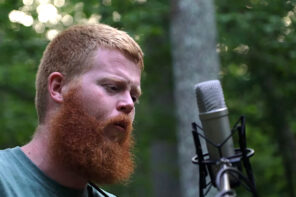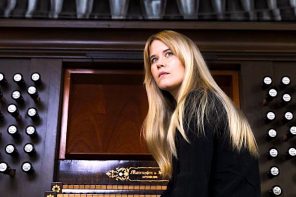It is overcast this morning at the Solar Stage of the Bonnaroo Music and Arts Festival, and about 75 people are getting ready for yoga. Some of them have brought their mats, others spread out their blankets, and there are some who lie directly on the worn grass of the farmland. Looking out over the group, we guess that a few of these festival-goers look like they may not have made it to sleep last night. The last performance of the previous day ended less than four hours ago.
The yoga takes place in “Planet Roo,” a cluster of booths in the center of this sprawling festival. Some of the larger stages are off in the distance, close enough that their sound checks will punctuate the movements of the exercise. This section of the festival grounds is the most visible attempt of the Bonnaroo organizers to give their extravaganza an edge of social consciousness. The Solar Stage itself is constructed of recycled materials with solar panels at its top, and it faces a squat, circular structure made of straw bales, adobe mud, old tires, and corrugated tin—the newest addition to the festival grounds—that serves as the festival’s post office.
As the yoga begins, booths from a slew of nonprofits are opening up. Most of them are focused on environmental causes—Carbon Shredders, Rock the Earth, Oceana—and some on human rights. Peaceroots, a coalition of antiwar organizations, is here and so is a voter registration group. But there is very little confrontational about the politics that Bonnaroo offers. “This way, you can go through all of these groups and find the thing that clicks for you,” one volunteer, a college senior, told us. Bonnaroo isn’t force-feeding political engagement on anyone. Instead, it presents a menu of dishes from which the festival-goer can select—or pass up altogether.
The same can be said of the yoga classes (and also Chi Gong and Tai Chi) offered by two different studios over the course of the morning. By mid-morning, the ranks will swell to about three hundred, a remarkable sight in the midst of this carnival, even if it is just a tiny fraction of the 75 to 80 thousand people who are attending Bonnaroo this year. Leading the class from the stage is Maria McGuire from the Gypsy Hands Healing Arts Center in Knoxville. “If you feel yourself come up against your limits,” she says at one point, “that’s okay. That’s where you are today. No one is going to judge you.”
Recent studies suggest that while the number of young Americans who consider themselves religious or spiritual remains roughly constant, their spiritual practices are changing. They are more likely than their parents to consider themselves unaffiliated with any particular practice, or the version of the religion they practice boils down to injunctions to a vague sense of morality, fairness, and happiness, what Christian Smith calls “moral therapeutic deism.”
Smith bases his conclusions on an extensive survey, followed up by hundreds of face-to-face interviews. He could have just come to Bonnaroo. Those who attend yoga each morning—the most overtly spiritual practice visible at the festival—talk about their desire to be “grounded,” to “center” themselves, or, more pointedly, to “detox,” a word that seems to have both literal and figurative meanings here. They all mention that the presence of the group that surrounds them gives their meditation and exercise here a distinct quality, but the purpose is directed inward. As one man, a twenty-something who works in finance, told us afterward, “You feel something else. You just feel yourself.” Participants tell us repeatedly that no one judges anyone else during these sessions.
Off to the side of the crowd, sitting against a tree, sits Laura Beth Circy, the only person whom we will see in our four days here reading a Bible. Circy has come to Bonnaroo with a friend working in one of the booths, and she describes herself as someone familiar with the excesses of the festival circuit. “It’s different coming here sober,” she says.
She also tells us that even though she does not actively proselytize, she has had a surprising number of conversations about her faith during her time at Bonnaroo. “The people here are trying to fill themselves up with something.” When she tells that she believes “there is a spiritual war going on right now,” we ask her which side Bonnaroo is on. Neither, she says. As the yoga proceeds behind us, she says that the experiences people have at Bonnaroo can be a step in their own awakening.
There are not many people explicitly flaunting their spiritual practices at Bonnaroo, but those who are all tell us a version of this same thing. “The people here are seekers,” says Te’Devan, a tall, 29-year-old man who walks the festival grounds with a hand painted sign advertising his services: “Intuitive Healing / Spiritual Healer and Counseler [sic] / Trained / Chi-Gong / Reiki / Shaman / Talk to Me.” Te’Devan travels from one festival to the next, and believes that the others who attend them are looking for meaning absent in materialist capitalism. He estimates that he talks to about a thousand people about his healing practices over the course of a festival like Bonnaroo, with maybe about three hundred approaching him for a substantive exchange. Sure enough, just as we end our conversation, a dusty, goateed young man is waiting for Te’Devan’s attention. In a few minutes, the two of them are seated on the ground, their eyes closed in meditation.
This would not have surprised Maria McGuire, the yoga instructor, at all. A practicing Catholic, she has been coming to Bonnaroo for years, where she also offers classes in body work and belly dance at an “academy” tent near the Solar Stage. Talking after her first yoga class of the festival, she mentions that Bonnaroo has played a key role in marking recent changes in her own personal life. She recalls, with some emotion, being asked to participate in an impromptu wedding conducted at the festival two years ago, an event that suggested to her the festival can yield genuine moments of transformation. “I believe this is a vibrational healing ground,” she says.
McGuire thinks that the power of Bonnaroo has something to do with the logistical, even bodily, difficulties of attending a four-day (and four-night) festival in the middle of rural Tennessee. “It’s a challenge to be here,” she emphasizes, pointing out that those who come to Bonnaroo often drive great distances, endure epic waits to enter the festival grounds, and then camp in a setting that offers little in the way of physical comfort. “People get turned inward and they find themselves being transformed.” She compares Bonnaroo to a spiritual “retreat” in the sense that the festival offers an experience that is prolonged and not always pleasant. And she is right. Whatever else it may be, Bonnaroo is an endurance event.
“People come to Bonnaroo because they feel the need to change,” McGuire continues. Like the others with whom we have talked, she connects what she does in her classes at the festival with what goes on at the bigger stages. “The bands are channeling something passionate, from the heart, something artistic. I feel that true art is spiritual.”
Over the course of the festival, McGuire might have the chance to instruct a thousand or so of the fans who have come to hear performers like Pearl Jam, Jack Johnson, and My Morning Jacket. It is hard to know how many of them would share her sense that the search for enlightenment could travel from her morning meditation to the late night jams and back again. She may be right about the denizens of Bonnaroo; they may, indeed, be seekers. But that does not mean that they understand what exactly they are seeking, or even that they are on a search. On the other hand, studies like Christian Smith’s suggest that American youth are not getting much instruction on that score from more traditional sources. At least at Bonnaroo, they have four hot days of chances, as they tromp from stage to stage, to ponder the dust beneath their feet.




